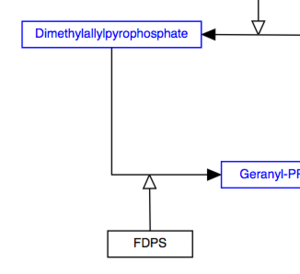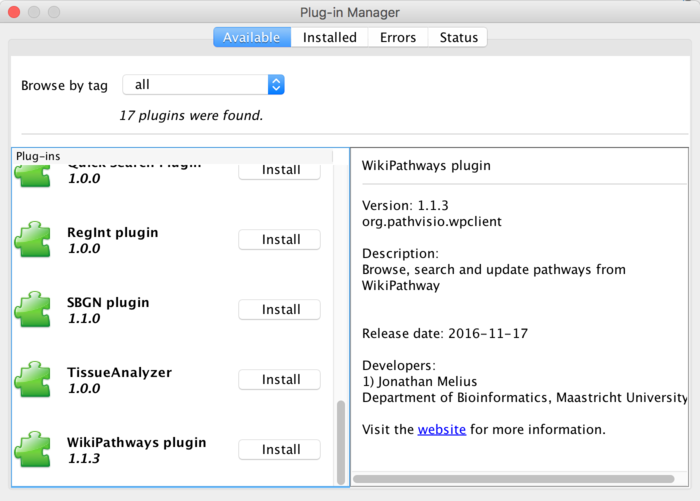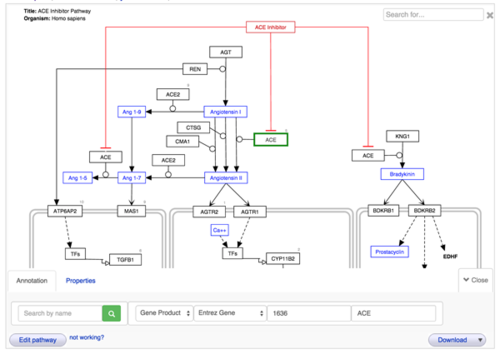Help:Editing Pathways
From WikiPathways
In addition to editing the text fields on a given Pathway Page, this wiki also supports the ability to edit the pathway itself! There are three options for editing a pathway at WIkiPathways:
- Edit any pathway in PathVisio, using the WikiPathways plugin
- COMING SOON: Make edits to data node annotation and style using the QuickEdit feature.
- Edit the pathway directly at WikiPathways using the embedded version of PathVisio.
Contents |
Editing in PathVisio with WikiPathways plugin
The WikiPathways Client plugin for PathVisio connects to WikiPathways and allows users to search and browse pathways from within PathVisio. It also enables updating of existing pathways, and uploading of new content.
Installation
- Download and start PathVisio.
- Open the via Plugins -> Plugin Manager.
- In the Available tab, click the Install button for WikiPathways plugin. When successfully installed the plugin will be listed in "Installed" tab.
Editing an Existing Pathway
For detailed information on how to use the plugin, see the plugin page.
- In PathVisio, find and open your pathway of interest by searching for the pathway identifier (e.g. WP4) or title.
- After making any edits, select Plugins -> WikiPathways -> Update. You will be prompted to enter your username and password, as well as a description of the edits. Note: if you do not have write access yet, please see our contact page to request this access.
- If the pathway was tagged with the Analysis Collection or Featured Pathway tags, you will have the option to update these tags as well.
Creating a New Pathway
- Launch PathVisio with the WP Client Plugin.
- Load the appropriate species database and the metabolite database, if applicable.
- Give your pathway name and assign a species: Select the "Pathway Information Area" (upper left corner), and in the "Properties" tab, enter a title in the "Title" field and select the correct species in the "Organism" drop-down.
- Create your pathway.
- Select Plugins -> WikiPathways -> Upload New. You will be asked to specify your login information and a description of the pathway.
- That's it! Now go to the New Pathways listing to see your pathway.
Editing using QuickEdit
COMING SOON
We are developing a new javascript pathway editor and the first version is a QuickEdit feature for editing data node annotation and style. When logged in, the QuickEdit button is located at the bottom center of the pathway view. Clicking the QuickEdit button opens the editor:
Editing data node annotation
- Select any data node to display its annotation in the annotation fields.
- To search for a new identifier, type in a gene name or label in the Search by name field and click the green Search button. Results are displayed in a separate results panel.
- Select an identifier from the list of results to assign it to the node.
- To change only the data node type or data source, simply select from the drop-down lists.
- To manually change the label or identifier, simply type directly in the corresponding field.
- Click the Save & Close button to save and exit QuickEdit.
Editing data node style
- Open QuickEdit.
- Select the relevant data node and click the Properties tab in QuickEdit.
- Use the color chooser to change the border and label color of the node, or use the buttons to set the label text to bold or italic.
- Click the Save & Close button to save and exit QuickEdit.
Editing in the embedded PathVisio editor
Clicking on Edit pathway on any Pathway Page opens an embedded version of the PathVisio program with the current pathway loaded. You can add, edit or delete content from the pathway and when you save, updated versions of the images, controlled text, and data files are generated and are immediately available.
PathVisio supports a number of common drawing tools, as well as an interface for linking objects on pathways to an underlying gene database. For instructions on basic editing features please refer to PathVisio documentation. In addition to the drawing features described for the PathVisio webstart program, the WikiPathways embedded editor has some additional features.
Below are brief instructions on the most commonly used editing features in PathVisio and the embedded PathVisio editor at WikiPathways.
Grouping objects
To group objects, first select the objects to be grouped by click and drag. Grouping the objects can be done in two ways: either right-click and select Group from the context menu or click ^G on your keyboard. The display of grouped objects does not change once the objects are grouped. When the cursor is placed over a group, a boxed outline will appear highlighting the grouped objects. Watch video.
Representing complexes
To create a complex, first select the objects in the complex by click and drag. Creating the complex can be done in two ways: either right-click and select Group from the context menu or click ^P on your keyboard. The display of a complex includes a boxed outline around the group. Watch video.
Selecting grouped objects and complexes
Grouped objects and complexes can be selected as a group, or as individual objects. To select the group as a whole (all group objects), click anywhere in the boxed outline surrounding the group. For complexes, this outline will be permanently visible, and for groups this outline will be visible only when the cursor is placed over the group. To select an individual object in a group, click the object directly.
| Selecting whole group |
|---|

|
| Selecting single grouped object |
|---|

|
Adding connectors between objects
Connecting line objects with gene and metabolite objects on pathways are important for properly storing the biological interactions that the pathway represents. To connect the end of a line to a gene or metabolite, select the end point of the line and drag it close to the object you wish to connect it to. A set of anchor points will appear on the outline of the object. Drag the end of the line over any of these anchor points until the anchor point turns green, then let go of the line end. This will connect the end of the line to the anchor point on the object.
| Adding connectors |
|---|

|
Objects that have anchor points that can be connected to lines are data nodes, metabolites, labels and graphical objects. Anchor points can also be added to lines (from the right-click menu), after which other lines can be connected to it.
Creating curved, elbowed, segmented and composite lines
For layout reasons and to properly represent biological interactions, non-straight lines are sometimes ideal. To create a curved, elbowed or segmented line, first create a new line by selecting the line object from the tool bar and dropping it on the canvas. Right-click on the line and under Line Type, select either Curved, Elbow or Segmented. The Curved option will produce a curved line with smooth edges, whereas the Elbow option will create a curved line with 90 degree edges. The Segmented option will let you define a line with one or more waypoints. To position the line, attach the end points to the desired objects as described above. The shape of the curved line will automatically adjust to fit the layout of the objects you are connecting. You can also change the shape of the line manually by dragging the way points (blue diamonds) on the line.
| Elbowed line |
|---|

|
To create a line which is a composite of two or more lines, add an anchor point to one of the lines by using the right-click menu. Connect the end point of the other line to the anchor point as described above. Anchor points on lines can be moved by clicking and dragging to a desired position on the line.
| Anchored line |
|---|

|
Save to WikiPathways.org
Save your pathway by clicking the Save the pathway to WikiPathways.org button in the toolbar.
Editing Pathway Page text fields
Text fields on Pathway Page is edited like any other text on a wiki. Please refer to the WikiMedia website for details on formatting.
Curation Tags
Curation tags can be added to a pathway to notify the author and community about the state of the pathway. For example, you could tag a pathway that isn't annotated properly or tag your own pathway as work in progress. Curation Tags can be added by clicking the green plus sign icon in the Curation Tags section. Choose the type of Curation Tag from the drop-down list and enter a comment if appropriate.
Description
Each Pathway Page includes a Description section, which contains information about the biological process described in the pathway. The Description can be edited by clicking the Edit link to the right of the Description section.
Bibliography
Each Pathway Page includes a Bibliography section, designed to hold reference information relevant to the pathway. When editing a pathway in the editor, any references to publications, textbooks and websites can be added to this section by right-clicking on any object in the pathway and selecting Add or Edit from the Literature menu. Details on how to incorporate literature references can be found here.
Ontology Tags
The Ontology Tags section contains any ontology tags added to the pathway. The interface for adding and editing ontology tags is currently disabled. A new version will be available in the future.
Creating a new pathway
You can create a new pathway at WikiPathways by clicking the Create new pathway link in the navigation panel on the left side of each page. For details on how to create a new pathway, refer to the New Contributor Quickstart guide.



